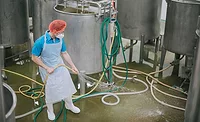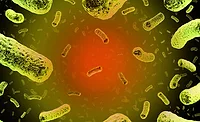Building a Comprehensive Food Safety Plan
Protecting consumers, preventing brand equity damage, and ensuring regulatory conformance

As food manufacturers, we have an obligation to protect our customers and consumers from hazards that can result in injury or illness. These hazards include microorganisms that can cause illness and chemicals such as food allergens and foreign objects that can cause injury or choking. It just makes good business sense to prevent illness or injury as these can lead to loss of customer trust, legal liability, and damage to brand equity and the company reputation, as well as potential regulatory control action and additional oversight.
With the aforementioned in mind, how does a company prepare a comprehensive food safety plan that will help prevent or reduce the potential for a food safety hazard within their manufacturing environment? In addition, how does a company ensure that the plan can be effectively implemented, is enforceable, and still allows for production efficiency? We would like to provide our recommendations for building a comprehensive food safety plan that will reduce potential for hazards, protect consumers, and conform to regulatory expectations.
Although the primary goal of creating your food safety plan is to prevent consumer illness or injury, it is important to recognize the regulatory requirements for developing your food safety plan. As a first step, become familiar with the regulations that impact your food operation and determine whether you are under the jurisdiction of the U.S. Department of Agriculture (USDA), the U.S. Food and Drug Administration (FDA), or are a dual-jurisdiction operation:
- Pathogen Reduction Hazard Analysis and Critical Control Points (HACCP) Systems Final Rule (USDA)
- Food Safety Modernization Act (FSMA), specifically for FDA-regulated products, reference 9 C.F.R. 417 Hazard Analysis and Risk-Based Preventive Controls (HARPC)
- Seafood HACCP (FDA)
- Pasteurized Milk Ordinance and/or FDA Guidance for the Manufacture of Frozen Desserts
All guidance and regulations are based on, and originate with, the Federal Food, Drug, and Cosmetic Act of 1938. This set of laws gives FDA authority to oversee the safety of food, drugs, medical devices, and cosmetics. Yes, you will need an HACCP plan for cosmetics as well!
After determining and understanding the base requirements, you are ready to dive in, right? Wrong!
Step 1: Assemble the HACCP/HARPC Team
The first thing one must do when assembling the HACCP/HARPC team is determine who is a “Qualified Individual” based on the guidance in FSMA. This is a reference to a Preventive Controls-Qualified Individual or someone who has been trained in the development and application of risk-based preventive controls. You want to determine who on the team has the education, experience, and in-depth process knowledge for the product you intend to manufacture. These are the individuals you will want on the HACCP team as they can help the team identify the risks associated with each step of the process.
Step 2: Describe the Product and Identify the Intended Use and Customer
Secondly, understand the product and identify the intended use and intended customer (retail, industrial, foodservice, deli, etc.) but also recognize the “unintended customer”—those who should not be consuming this product yet might do so. If it is a higher risk for the elderly, children, and the immunocompromised, then call this out immediately and, based on HARPC, determine what preventive controls can be put in place to eliminate or mitigate the risk to those consumers. This is an important step in building the food safety plan.
Looking for quick answers on food safety topics?
Try Ask FSM, our new smart AI search tool.
Ask FSM →
Step 3: Construct the Flow Diagram of the Process and Verify Accuracy
Next, you will need a thorough flow diagram of the manufacturing process, and this is where having team members with thorough knowledge of the process is invaluable. It is a good idea, once the flow diagram has been completed for the process, to have the team go to the production areas and walk the process with the flow document to ensure that no steps have been missed and that the order is correct.
One step many manufacturers skip or forget is purchasing and ingredient supply; a written supply chain program is a FSMA requirement for covered facilities. All risks start with who and where you purchase the raw materials from for your product. This cannot be emphasized enough, particularly since many ingredients and raw materials are purchased from overseas locations. Your team must have the knowledge (or seek out the information) on the country, region, facility, etc. where that raw material is being manufactured. This is an important step because the FSMA guidance clearly indicates that anything food or cosmetic imported into the U.S. must meet or exceed all current U.S. guidance and regulations. As an example, you may want to consider the points listed below.
- How clean is their water? Do they use well water? Know and understand the U.S. Primary Drinking Water Regulations and when and how reclaimed water is allowed in food manufacturing.
- Many countries have very different environmental regulations, if any, and groundwater, soil, etc. may become contaminated or adulterated simply by using the well water to clean equipment or add as an ingredient to what you intend to purchase.
- Where is the facility located and is there any risk from the manufacturing plant or a neighboring facility? Has there been a recent release by a local chemical or nuclear facility?
- This step will include the requirements for food fraud and food defense. Determining who is actually the importer of record versus “the importer” also makes a difference.
Each step of the process then flows after purchasing—receiving, storage, allergen control, mixing/blending, cooking, where water is added to the process, where all the ingredients are added (some are prelethality and some may be postlethality)—and you’ll need to document this on the flow. Then identify where the product goes from there—freezing, smoking, packaging, packing, storage (and allergens again)—and when is it shipped. Consider how it is shipped (e.g., common carrier, company truck) and where it ships (e.g., third-party warehouse or direct to customer). Once product arrives at the customer location, does your company liability for food safety stop or does liability remain, even if the end customer modifies the product through meal kit preparation, for example. Remember, you cannot always control what happens to the product once it is out of your control, and mishandling, temperature abuse, or tampering may be possible once the product leaves your facility. Understanding the steps in the food chain will help you identify potential risks and prepare to mitigate them as well. They are part of your food safety plan.
Step 4: Conduct the Hazard Analysis
For each step in the process flow your team has developed, assess and identify the associated hazards. Hazards to consider are generally broken down as:
- Microbiological – Typically, organisms of human health concern and may vary depending on your product. This may include bacteria (Salmonella, Listeria monocytogenes), viruses (hepatitis, norovirus), prions (bovine spongiform encephalopathy/variant Creutzfeldt-Jakob disease), or parasites (Trichinella, Cyclospora).
- Chemical – Typically, food allergens (milk, soy, wheat, egg, peanuts, tree nuts including coconut, fish, and crustacean shellfish), and sensitizing ingredients (gluten, sulfites) but should also include consideration of radiological materials.
- Physical – Typically, hard foreign material that may result in injury or choking (e.g., hard plastic, metal, stone).
Both USDA and FDA regulations require prerequisite programs or preventive controls that address these hazards. These include, but are not limited to, Sanitation Standard Operating Procedures, Good Manufacturing Practices (GMPs), and allergen management. These may help prevent or mitigate a serious food safety hazard and answer such questions as: Where are allergens introduced or controlled? How are GMPs controlled? How is sanitation possibly affecting my risks?
Step 5: Determine CCPs and Establish Critical Limits
Determine whether any of the steps assessed is a CCP or a risk-based preventive control (RBPC). How is that step controlled or risk reduced to an acceptable level, and who/where in the process is that designed to happen? An example of a CCP in a hot dog or sausage process may be cooking to a temperature that is lethal to pathogens that may be in meat or poultry components. Of course, with a CCP or RBPC, there must be an established limit that either must be met or cannot be exceeded. Critical limits are established through scientific research, regulatory requirements (e.g., USDA Appendix A for cooked meat or poultry products), or historical plant data. They must be supported to be valid limits.
Step 6: Establish Monitoring and Corrective Actions
Determine where in the process these CCPs or RBPCs are monitored and who will conduct the monitoring. Those responsible for the monitoring must receive documented training to ensure that they know what is being monitored, how it is to be monitored, and why it is necessary. They must understand that documentation is required as well as how the document is to be prepared (e.g., no erasure, how to correct an error, accuracy, legibility, etc.). This may be a simple form or an automated system that collects the data for you. It is also necessary to provide the proper tools for the personnel conducting monitoring such as calibrated thermometers. Finally, you also must determine who is qualified to review and validate the data being collected and how that is then documented.
What happens when my process goes out of control and I exceed my established limit? That is your team’s next question. The team and management must decide what corrective action to implement, if any, and ensure compliance. Actions to be taken typically include:
- Controlling all product to the last acceptable check to ensure that no adulterated product enters commerce.
- Identifying and correcting the cause of the process deviation.
- Bringing the CCP or RBPC under control.
- Establish measures to prevent reoccurrence.
Step 7: Establish Verification and Record-Keeping Procedures
Verification and validation were discussed earlier, but do remember these are integral pieces of a food safety plan using HACCP and/or HARPC. Validation and verification are two distinct processes. Validation is the process of proving that the actions you take are providing a safe, wholesome process. Verification is the practice of ensuring that you are doing the things you have identified will provide a safe, wholesome product. Obviously, since we are collecting data and filling out forms, we must also determine how long we keep the records and how we control the records. Two points for consideration as to how long documents are retained are regulatory requirements for document retention and the shelf life of the product. As a rule, it’s a good idea to keep documents a year past the shelf life of the product, if possible.
Remember that this plan is specific to your operation and should be reassessed at least on an annual basis. However, it should also be reassessed if there are significant changes to your operation, introduction of potential new hazards (e.g., allergen ingredients), or as result of a product action such as a recall or market withdrawal. Even though everything may appear to go right in your process and all documentation indicates that the process is in control, there may be a need for you to recall the product. A recall policy and plan are required for plants to ensure that they can identify and retrieve product if it is deemed to be out of compliance or presents a health hazard. The company recall plan should be tested periodically to ensure it is effective and reassessed annually along with the HACCP or HARPC plans.
We hope you have found this information to be useful for the development or improvement of your food safety plan. Preventing food safety hazards is a more effective means of protecting consumers than detection and reduces the potential for negative publicity and further regulatory oversight.
Michael Barnes, M.Sc., is the corporate microbiologist/sanitarian for Ajinomoto Foods North America. He served 27 years in the U.S. Army Veterinary Corps, holds an M.Sc. in food science/food microbiology from Kansas State University, and has worked in the food manufacturing industry for 15 years. He is a Certified Food Scientist, Certified Quality Auditor, Certified HACCP Auditor, and instructor for the Foreign Supplier Verification Program.
Michael Cramer is senior director of food safety and quality assurance for Ajinomoto Foods North America. He is a graduate of West Chester University with a B.Sc. in health science. He has spent over 40 years in food manufacturing for meats, poultry, and frozen entrées. He authored the book Food Plant Sanitation as well as numerous articles for Food Safety Magazine, where he is a member of the editorial advisory board. He is a Certified Quality Auditor and PCQI.








